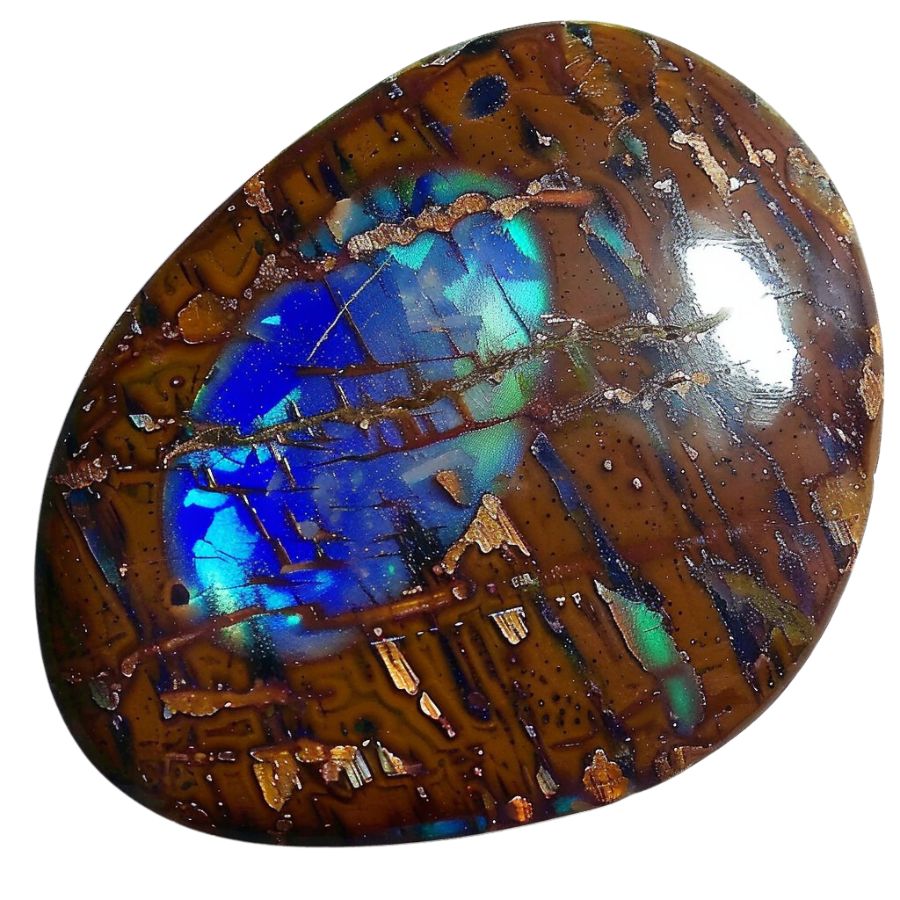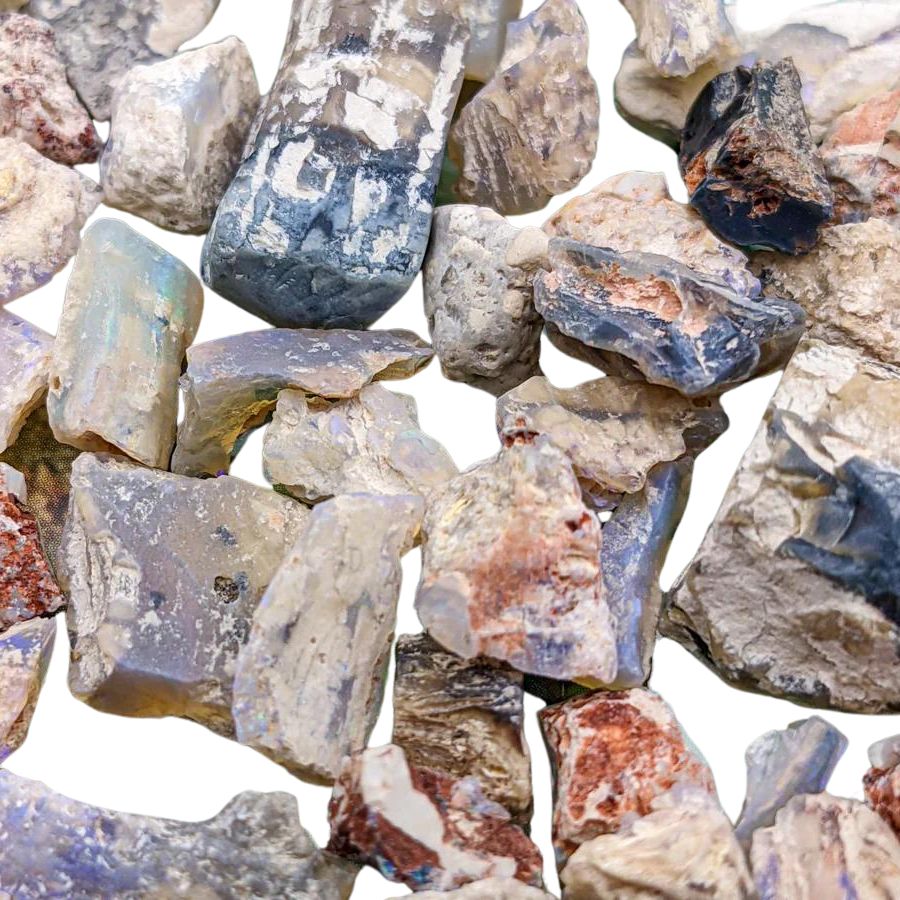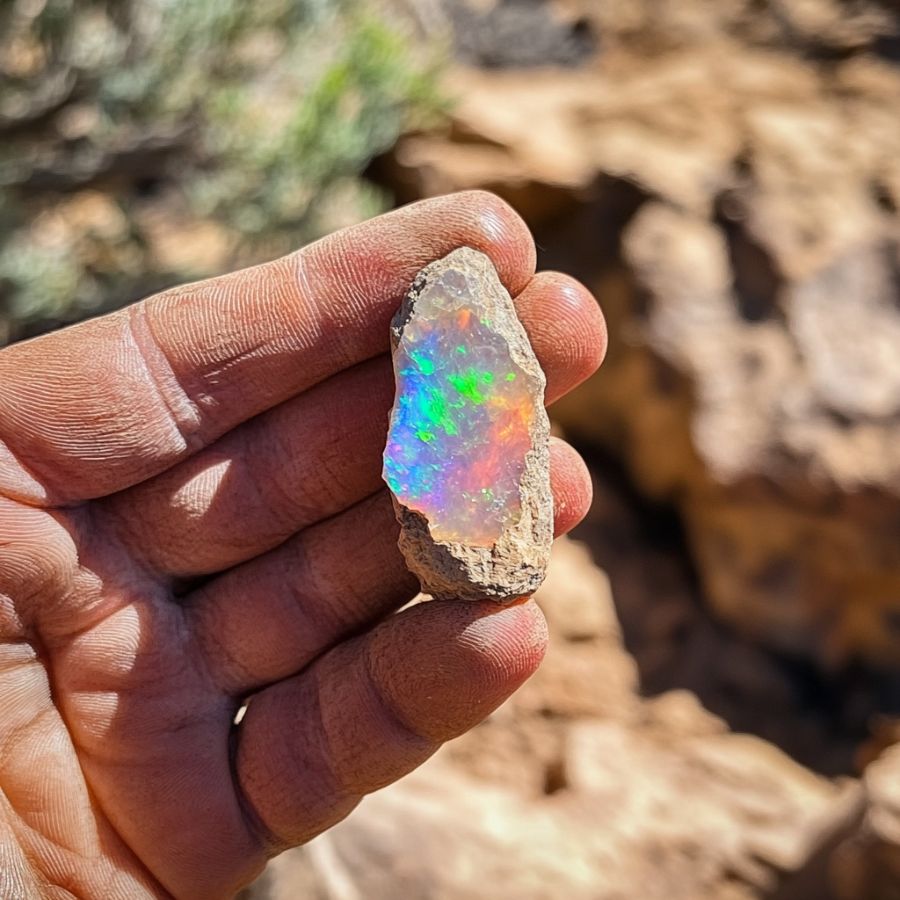Hunting for opals is an exciting adventure that combines the beauty of nature with the thrill of finding precious stones. In a state famous for its diverse landscapes, people can enjoy the quest to uncover these colorful gems.
Our state, with its special geological features, offers a great place for opal hunters. We’ll explore the best spots to find opals, the tools you need, and helpful tips for a successful hunt.
Whether you’re experienced or just starting, this guide will help you find opals in this gem-rich area.
How Opal Forms Here
Opal forms here through a fascinating natural process. When water containing silica seeps into cracks and voids in rocks, it begins to evaporate, leaving behind tiny silica spheres.
Over time, these spheres stack in a grid-like pattern, creating opal. This process can take millions of years!
The colors in opal come from the way light refracts through the silica spheres. Different conditions in the ground, like the type of rock and the presence of other minerals, can affect the opal’s type, color, and quality.
The Types Of Opal
There are several incredible types of Opal that can be found. Each is uniquely beautiful and interesting including:

Common Opal
Common opal, also known as “potch,” stands out from other types of opal due to its lack of play-of-color, the iridescent display seen in precious opal. Instead, common opal features consistent, solid colors like white, pink, yellow, green, and blue.
It typically has a waxy to pearly luster and ranges from opaque to translucent. To identify common opal, look for its uniform color and absence of the shimmering color flashes found in precious opal.
Common opal forms under similar geological conditions as other opals, where silica-rich water seeps into rock cavities and slowly hardens over time. This process usually occurs in areas with volcanic activity or hot springs, where silica deposits are prevalent.

Fire Opal
Fire opal is known for its warm, vibrant colors, ranging from yellow and orange to deep red. Unlike precious opal, fire opal may or may not display the play-of-color, but its fiery body color makes it unique.
To identify fire opal, look for its bright, translucent to transparent appearance and the absence or presence of play-of-color within the warm hues.
Fire opal forms in volcanic regions where water rich in silica interacts with hot lava, filling cavities and fractures within the rock. Over time, the silica solution hardens, creating opal.
Visually, fire opal’s appeal lies in its vivid, flame-like colors that can be either uniform or exhibit internal flashes of color.

Boulder Opal
Boulder opal forms within the ironstone boulders of its host rock. Unlike other opals, boulder opal features precious opal veins intertwined with the natural rock, creating a beautiful contrast.
This opal is distinguished by its combination of colorful opal patches and the surrounding matrix, which can include ironstone or sandstone. To identify boulder opal, look for its vibrant play-of-color within the darker host rock, often showcasing brilliant blues, greens, and reds.
Boulder opal forms in sedimentary environments where silica-rich water infiltrates cracks and voids within ironstone or sandstone boulders. Over time, the silica hardens into opal, often creating thin seams or patches within the rock.

Hyalite Opal
Hyalite opal, also known as water opal, is a transparent to translucent type of opal that is distinctive for its glass-like appearance and lack of play-of-color. Unlike precious opal, which displays a rainbow-like iridescence.
You can identify hyalite opal by its clear to milky appearance, often with a slight green or blue fluorescence under UV light.
Hyalite opal forms in low-temperature hydrothermal environments, typically in volcanic regions. It precipitates from silica-rich fluids that fill cracks and voids in the host rock. This process can occur relatively quickly compared to other opal types.
Visually, hyalite opal resembles droplets of water or glass, often appearing as smooth, botryoidal (grape-like) formations. Its transparent nature makes it unique among opals, and its slight fluorescence adds to its allure.

Black Opal
Black opal is a rare and highly prized variety known for its dark body tone, which enhances the vibrant play-of-color. Unlike other opals, black opal has a deep background color, ranging from dark gray to jet black, making the iridescent colors more striking.
To identify black opal, look for its intense, dark base color coupled with brilliant flashes of blues, greens, reds, and other hues.
The presence of iron and carbon contributes to its dark body color. In the United States, black opal is primarily found in the Virgin Valley of Nevada, known for its rich opal deposits.

Crystal Opal
Crystal opal is known for its transparent to translucent body, which allows the play-of-color to shine through brilliantly. Unlike common opal, which is opaque, crystal opal’s clear or semi-clear nature enhances its vibrant internal colors.
To identify crystal opal, look for its see-through quality combined with flashes of color that can include blues, greens, reds, and more.
Its unique transparency sets crystal opal apart, making it a favorite among gem enthusiasts and collectors for its ethereal beauty.

Wood Opal (Opalized Wood)
Opalized wood is a fascinating form of petrified wood where the organic material has been replaced by opal. Unlike other opals, opalized wood retains the original structure and texture of the wood, creating a unique blend of organic and mineral elements.
To identify opalized wood, look for its wood grain patterns and opalescent sheen, often displaying a range of colors from white and brown to vibrant reds and greens.
Opalized wood forms under specific conditions where wood is buried in silica-rich sediment. Over millions of years, the silica solution gradually replaces the organic wood material with opal, preserving the wood’s original structure in stunning detail.

Contra Luz Opal
Contra Luz opal reveals its vibrant play-of-color when illuminated from behind. Unlike other opals, which display their colors through surface reflection, contra luz opal’s brilliance comes to life with transmitted light.
To identify contra luz opal, hold the gem against a light source and observe the internal flashes of color, which can include vivid reds, blues, greens, and purples.
This opal forms in volcanic environments where silica-rich water infiltrates cracks and cavities in the host rock. As the water evaporates, it leaves behind silica deposits that eventually solidify into opal.
Visually, contra luz opal appears nearly clear or milky when viewed without backlighting. However, when backlit, it displays stunning, colorful patterns that seem to glow from within.
What Rough Opal Looks Like
When you’re out looking for rough opal on your own it’s important to know what you’re looking for. This is what you need to look out for:
Look for exteriors like this

Look for play-of-color

Opal can display a range of colors, but what sets precious opal apart is its play-of-color—vivid flashes of multiple colors that change with the angle of light. Even in rough form, you might see hints of these colors peeking through.
Common opal lacks this feature and typically appears as a solid color like white, blue, or pink.
Check for a glassy or waxy luster

Opal often has a distinctive glassy or waxy luster. When you find a potential opal, examine its surface.
It should look shiny and smooth, almost like glass, even if it is still encased in a matrix or rough exterior.
Assess the density and weight

Opal is generally lighter than rocks of a similar size. When you pick up a piece of rough opal, it should feel lighter than expected.
Additionally, opal is relatively soft, with a Mohs hardness of 5.5 to 6.5, so it can be scratched more easily than quartz or other harder minerals.
A Quick Request About Collecting
Always Confirm Access and Collection Rules!
Before heading out to any of the locations on our list you need to confirm access requirements and collection rules for both public and private locations directly with the location. We haven’t personally verified every location and the access requirements and collection rules often change without notice.
Many of the locations we mention will not allow collecting but are still great places for those who love to find beautiful rocks and minerals in the wild without keeping them. We also can’t guarantee you will find anything in these locations since they are constantly changing.
Always get updated information directly from the source ahead of time to ensure responsible rockhounding. If you want even more current options it’s always a good idea to contact local rock and mineral clubs and groups
Tips on where to look
Once you get to the places we have listed below there are some things you should keep in mind when you’re searching:
Search in Sedimentary Rock Formations

Opal can also form in sedimentary rock formations where silica deposits have accumulated over time.
Focus on areas with ancient lake beds or clay deposits, as these environments are conducive to opal formation.
Check Dry Creek Beds and Gullies

Dry creek beds and gullies can be excellent places to find opal, as water flow can erode and expose opal-bearing rocks.
Look for exposed rock and gravel in these areas, especially after rainfall or seasonal flooding.
Investigate Old Mining Sites

Abandoned or historical mining sites can be rich in opal and other minerals. These areas often have tailings and discarded rock that may still contain opal.
Always seek permission if the land is privately owned and follow safety guidelines.
Look for Indicator Minerals

Certain minerals can indicate the presence of opal. Look for rocks and soil containing ironstone, sandstone, or clay, as these materials often coexist with opal deposits.
Additionally, finding quartz or chalcedony can suggest nearby opal.
The types of Opal can you find around the state
Texas offers a select variety of opals, specifically precious opal, fire opal, and hyalite. These types are notable for their unique visual properties, appealing to collectors and gem enthusiasts alike.
Some Great Places To Start
Here are some of the better places in the state to start looking:
Alpine

Alpine is nestled in a valley at the foothills of the Davis Mountains, offering a unique mix of desert and mountain landscapes. It boasts rolling hills, wide-open skies, and an array of vibrant desert plants.
This area is a patchwork of rugged terrain, with elevations that provide a variety of different views and experiences. The geology here is diverse, featuring volcanic rocks from ancient eruptions and a variety of minerals that hint at a complex geological history.
The region’s layers of sedimentary rock tell stories of times when this area was covered by seas and lakes, leaving behind rich fossil beds.
There are igneous rocks in the higher elevations, and throughout the area, there are signs of the tectonic movements that shaped these mountains. For rock collectors, this means a chance to find a range of specimens, from colorful agates to interesting fossils.
When planning to collect rocks in this region, make sure that you know the rules. You can check with local authorities like the Texas Parks and Wildlife Department to get up-to-date information on what can be collected and where it’s legal to explore.
Where we found opal in Alpine
When exploring where to mine for opal in Alpine, you’ll encounter a terrain that’s a blend of rocky outcrops and desert landscapes. Opals can be unearthed at several notable spots like Ritchie Ranch and Woodward Ranch.
Freer

Freer sits on a flat to gently rolling terrain with an arid climate that’s typical of a semi-desert. The area is known for its brush country, where mesquite and prickly pear cacti are common sights.
Geologically, it’s part of a region characterized by sedimentary rocks, such as sandstone and shale, which tell the story of an environment that was once very different – likely a shallow marine setting eons ago.
This is evidenced by the fossilized remains of ancient sea life found within these stone layers. The soil here is a mixture of sand and clay, supporting the scrubby vegetation that thrives in this dry landscape.
Where we found opal in Freer
Fire opal has been discovered in Freer, adding to the allure of the area for rock enthusiasts. This vibrant variety of opal can be found on Cedro Hill, a location that provides the right geological conditions for its formation.
Christmas Mountains

The Christmas Mountains are known for their rugged and scenic landscape. This area is a range of mountains that rise abruptly from the surrounding desert floor, creating a striking visual contrast.
The geology of these mountains is complex, with a mix of volcanic rocks, such as basalt and rhyolite, which hints at the area’s volcanic past. The hills are covered with a variety of desert shrubs, and the mountains feature steep slopes and rocky cliffs.
These geological formations provide a haven for a diverse array of plants and animals and offer numerous opportunities for outdoor activities and rockhounding.
Where we found opal in the Christmas Mountains
The Christmas Mountains harbor a variety of rocks and minerals, including Texas opal. This opal is typically found in areas where volcanic activity has occurred, which is evident in the mountains’ terrain of rugged lava flows and ash beds.
Edwards Plateau

The Edwards Plateau is a region of rolling hills, broad valleys, and a rocky landscape that sits above a vast limestone foundation.
This geological layer is part of a larger area known for its karst topography, characterized by numerous caves, sinkholes, and underground streams that have formed due to the dissolving rock.
Meanwhile, the plateau’s land is a mix of grasslands and wooded areas, providing a diverse habitat for wildlife.
The limestone bedrock of the region contains fossilized remains from a time when the area was covered by a shallow sea, making it a spot of interest for both geologists and paleontologists.
Where we found opal in Edwards Plateau
Opal in the Edwards Plateau area is usually found in places where water has flowed through the limestone, leaving behind silica-rich solutions that solidify into opal. These spots are often along hillsides or in the beds of dry creeks where water once ran.
Quitman Mountains

The Quitman Mountains feature a rugged and elevated landscape, with peaks that offer expansive views. They are part of a larger range that includes valleys and steep slopes, characterized by a variety of rock types.
Geologically, these mountains consist of igneous and sedimentary rocks, indicating a history of volcanic activity and layered deposits from water bodies that once existed there.
The area is dotted with a variety of shrubs and hardy desert plants, adapted to the mountainous and semi-arid climate. The diverse rock formations provide a canvas for studying the earth’s movements and changes over time.
Where we found opal in Quitman Mountains
Knowing how to find opal in Texas means looking for the right geological clues, like areas with past hydrothermal activity which is typical for opal formation.
The rocky slopes and occasional flatlands of the Quitman Mountains are the kinds of places to examine.
Always Confirm Access and Collection Rules!
Before heading out to any of the locations on our list you need to confirm access requirements and collection rules for both public and private locations directly with the location. We haven’t personally verified every location and the access requirements and collection rules often change without notice.
Many of the locations we mention will not allow collecting but are still great places for those who love to find beautiful rocks and minerals in the wild without keeping them. We also can’t guarantee you will find anything in these locations since they are constantly changing.
Always get updated information directly from the source ahead of time to ensure responsible rockhounding. If you want even more current options it’s always a good idea to contact local rock and mineral clubs and groups
Places Opal has been found by county
| County | Location |
| Baker | Swayze Creek |
| Harney | Burns area, Silvies Canyon in Myrtle Park |
| Jefferson/td> | Madras area, Fulton Agate Beds |
| Jefferson | Round Butte Cinder Pit |
| Lake | Glass Buttes |
| Lake | Plush area, Hart Mountain |
| Lane | Hobart Butte |
| Malheur | Lake Owyhee State Park |
| Malheur | Succor Creek |
| Morrow | Opal Butte |
| Wasco | The Dalles, Chenowith Creek |

